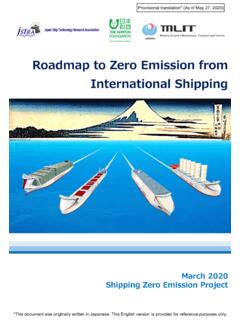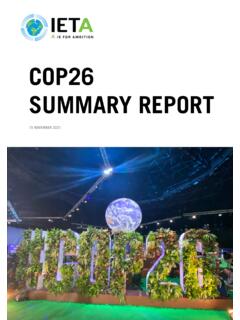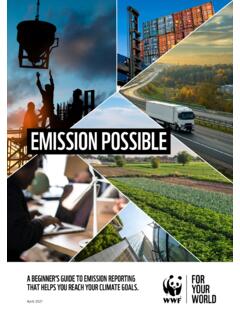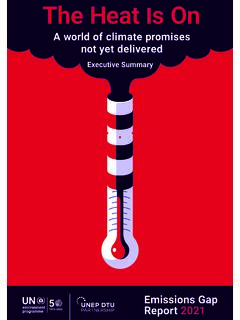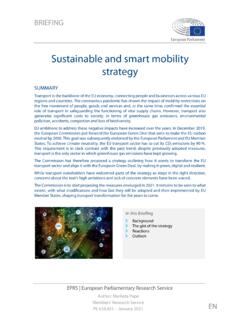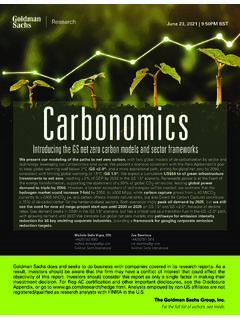Transcription of Industry Transition Strategy October 2021
1 1We show the world it is possibleIndustry Transition StrategyOctober 2021 We show the world it is possible!.It is high time for real climate action. IPCC s recent PhysicalScience Basis report about the climate was called a CODE RED for Humanity by the UN Secretary General Guterres and it is widely acknowledged across nations, regions and sectors that the climate crisis is caused by human influence. There is a global case for change with a strong sense of urgency as the window of opportunity to act in time is closing. shipping is a large global sector and a central player in multiple global systems. As part of all major supply chains, other sectors and countries depend on the shipping Industry to decarbonize but at the same time they strongly influence our ability to do so.
2 It is a daunting challenge, but we can t let the complexities and risks paralyze us. As individuals, as leaders and as a responsible shipping sector, we must all play an active role. Fortunately, many frontrunners are now acting the big question is how we make this initial action ignite a sector-wide transformation towards truly sustainable operations at sufficient scale and speed. As the challenge is systemic, and no individual organization can drive the Transition on its own, the M rskMc-Kinney M ller Center for zero Carbon shipping was established as an independent player in the eco-system to help accelerate the Transition through collaboration. With our partners we facilitate the development of feasible Transition pathways, as presented in this Industry Transition Strategy , and then help enable these pathways to materialize.
3 A key objective of this Strategy is to further strengthen the platform for collaboration by proposing a framework for the Transition narrative and summarizing what we know today. The Strategy is underpinned by deep multi-disciplinary analysis about energy, fuels, technologies, financial instruments, economics, and regulatory measures and it is our ambition to continue this open collaborative process to co-create the Transition narrative from the highest global level and to the most detailed atomic level. We hope this common framework across the governing disciplines of finance, technology, energy, and policy will help a broad range of stakeholders engage and collaborate effectively on our common mission of decarbonization.
4 This significant task of strategizing on sector level will evolve throughout the Transition . We will remain determined to expandand deepen the collaboration with the determined and courageous leaders of the maritime eco-system to turn this Strategy into real climate action. Enjoy the reading!Bo Cerup-Simonsen, CEOPage 2 ContentPage 3 Executive summary PrefaceGlossaryThe Path We Are OnThe ChallengeWhat does it take to carve a path to zero in 2050?What needs to happen in the next decade?Deep-divesAppendix040506071423424 965 Executive summaryZero carbon shipping can become reality by 2050 zero carbon shipping is indeed possible by 2050 with right cross-sector collaboration, Industry leadership and effective global regulationToday, The Path We Are On leads to more emissionsCommitment levels to make green Transition are on the rise in the maritime Industry .
5 However, even if all ongoing and planned efforts succeed, the maritime Industry emissions may increase by ~20% by 2050 First movers are critically importantPublic and private action in the short term is possible and critically important, to demonstrate that decarbonization is possible. First-mover opportunities can be leveraged before global regulation is in place Transition pathways are many, driving complexitySeveral fuels can replace fossil fuels used today to drive decarbonization. Moreover, there are various technological options to use these fuels onboard. This means there is no one size fits all approach driving decarbonizationIndustry leadership can t drive the Transition aloneFirst movers in the maritime Industry have clearly demonstrated their willingness to go green.
6 But, realization of current ambitions will only result in <10% emissions reduction vs. 2020, at notably high cost Cost gap fossil vs. alternative fuels is wide Alternative fuels production is ~2-8x costlier than the price of fossil fuels. Such a wide gap cannot be closed by technological progress alone. Additional Industry measures are needed to bridge the cost gaps Industry action and global carbon pricing can close gapsBesides reduced cost of fuels, improved customer s willingness to pay, reduced cost of green financing, increased energy efficiency adoption combined with a global policy on carbon levy can pave the way for the Transition It matters how a carbon pricing is designed A global carbon price in the range of USD 50-150/tCO2-eq can support both developing countries.
7 And early adopters of alternative fuels if revenue is earmarked and recycled back to the industryActions in four key areas is needed in next decade Maritime decarbonization requires: (1) Industry -wide energy efficiencyadoption; (2) alternative fuel scaleup; (3) a well-designed global carbonlevy; and (4) support to the firstmoversSeveral alternative fuel options will co-exist Industry action and policy can narrow the fuel pathways to decarbonization. However, irrespective of the pathway to zero , several alternative fuel options will co-exist as part of the fuel mixPage 4 PrefaceA Transition Strategy This Transition Strategy is the first of its kind produced by the M rskMc-Kinney M ller Center for zero Carbon shipping (also referenced to as the Center in this document).
8 In the coming years we will publish similar strategic documents to articulate how we view the Transition towards zero -carbon shipping and provide our recommendations based on the latest research and knowledge. Our views and conclusions will change over time as new technologies mature and regulation Transition Strategy document reflects Center-produced analyses based on publicly available data, Industry data provided by the Center s partners and output from NavigaTE the techno-economic model developed by the aim with this Strategy is to: Provide a science-based, independent perspective of what it takes to decarbonize themaritime Industry by 2050 Outline the relevant levers within technology, regulation and financing that will have thegreatest positive impact on the Transition Point at immediate actions that will help unlock and accelerate the Transition Motivate and engage maritime Industry participants, regulators and investors totake responsibility and start acting nowAdditionally, we hope that this document can be a steppingstone for the maritime Industry to engage in projects that not only focus on achieving net- zero by 2050.
9 But trigger action today and in the net- zero emissionsThe Paris Agreement isa landmark in climate change as it is the first binding agreement bringing countries together to a achieve a climate neutral world by 2050. More specifically, it is a legally binding international treaty on climate change entered into force on 4 November 2016 with a goal tolimit global warmingto well below 2oCelsius and preferably to , compared with pre-industrial essence of the Paris agreement is that countries have committed to reduction targets, but certain sectors such as maritime transport were not addressed. It is expected, however, that maritime transportation will be included in the future version of the Paris agreement.
10 If the maritime Industry is to contribute to a sustainable future pathway, emissions must fall precipitously, despite an increase in global trade and demand for transportation. In this Strategy paper we explore the core challenges and opportunities for the maritime Industry followed by actions and scenarios of what it will take tocontinue to be a thriving Industry while reaching net- zero 5 Alternative fuels Alternative fuels are derived from sources other than petroleum; some are derived from renewable sources. Often, they have a lower environmental impact than fossil-based category, generally in liquid form, produced from biomass. Biofuels currently include biomethane from wet waste or agricultural waste, hydrothermal liquefaction crude from biomass, bio-methanol, and biodiesel from canola or a near-pure source of methane produced either by upgrading biogas (a process that removes any CO2and other contaminants present in the biogas) or through the gasification of solid biomass followed by methanation.
